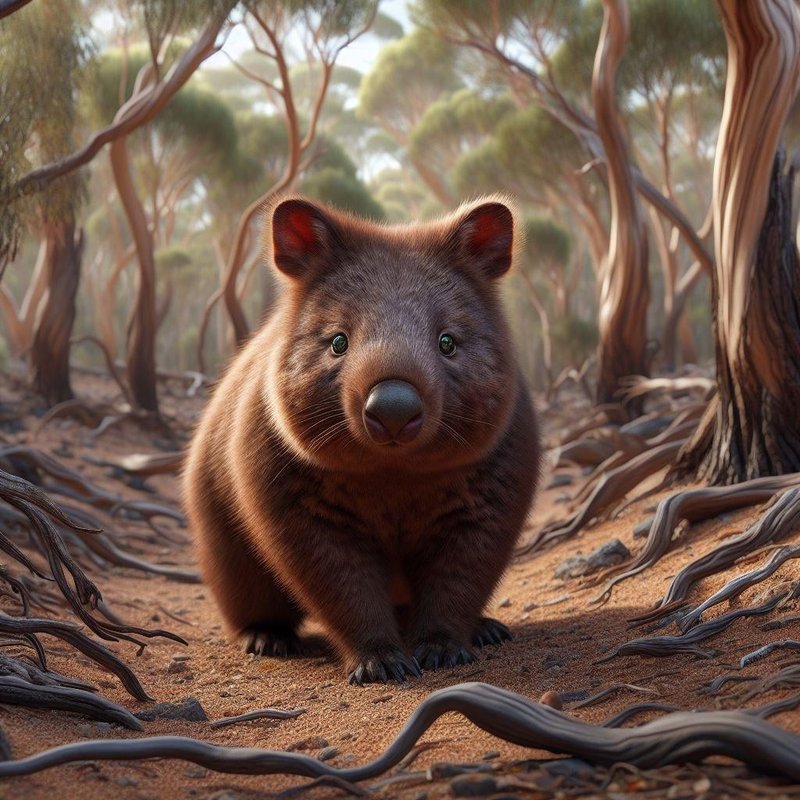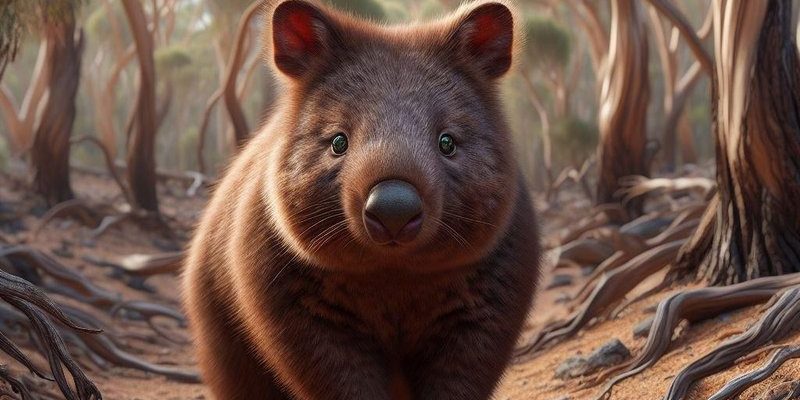
Imagine the wombat as a tiny piece of a huge puzzle that makes up Earth’s history. Each piece tells a significant story about how life has adapted and changed over time. From their ancient relatives to the specific adaptations that help them survive today, the evolutionary history of the wombat is a captivating journey. Let’s dig in! (Pun intended!)
Wombat Origins: A Look Back in Time
The story of wombats begins around 30 million years ago during the Oligocene epoch, a time when Australia was home to an amazing variety of flora and fauna. Wombats belong to a group called **Diprotodontia**, which includes kangaroos, koalas, and other marsupials. Their early ancestors were much different from the wombats we know now.
Early wombat relatives were larger and had a different lifestyle. While today’s wombats are primarily herbivorous and favor a burrowing lifestyle, their ancestors were more diverse in their diet and habitat. Some species grazed in open forests, while others may have preferred more wooded areas. It’s fascinating to consider what these animals looked like!
Over millions of years, as Australia’s climate shifted, wombats also adapted. They became more specialized for life in dry, open environments. This specialization led to a more robust body shape, which is great for digging. If you’ve ever seen a wombat tunnel, you know how impressive their burrowing skills are!
The Importance of Adaptations
Wombats have some truly remarkable adaptations that help them thrive in their environments. One of the most notable features is their stout, muscular build. This isn’t just for show; their strong bodies are designed for digging. Wombats can create extensive burrow systems that provide shelter from predators and extreme weather conditions.
Burrowing Behavior: Wombats are expert diggers. Their claws are adapted for digging, allowing them to carve out intricate burrows that can extend up to 100 meters! These burrows not only protect wombats from predators but also help regulate their body temperature. Who knew being a couch potato could be such hard work?
Teeth and Diet: Wombats have large, strong teeth that continue to grow throughout their lives. This is crucial since they primarily feed on tough, fibrous grasses. Their teeth wear down naturally as they grind through their food. Can you imagine if your teeth just kept growing?
Ancestral Lineage: Where Do Wombats Fit In?
To understand wombats’ evolutionary history, it helps to consider their relatives. The Diprotodontia group, which includes wombats, is one of the largest groups of marsupials. They share common ancestry with animals like kangaroos, koalas, and even some extinct species.
Ancient wombat relatives were part of a much larger family tree. Some of the more prominent ancestors include the *Diprotodon*, a giant wombat-like creature that lived during the Pleistocene epoch. These fascinating creatures were the size of a small car!
In contrast, today’s wombats are relatively small, yet they still carry traits from their larger ancestors. Some adaptations, including their burrowing habits and herbivorous diet, have persisted through time, showcasing the remarkable resilience of marsupials in adapting to environmental changes.
The Role of Climate Change in Wombat Evolution
Climate change has played a significant role in shaping the evolutionary history of wombats. As Australia transitioned to a more arid landscape, many animals had to adapt to survive. Wombats, with their burrowing lifestyle and favorable diet of grasses, found a way to thrive.
During periods of climate fluctuations, those wombats that could efficiently dig for food and create shelters to escape extreme weather had a greater chance of survival. Imagine being a wombat navigating a changing world—you’d have to be tough and smart!
In addition to helping them survive, these adaptations also shaped their behavior. Wombats became more nocturnal, avoiding the heat of the day. If you’re ever lucky enough to spot one, it’ll likely be late in the evening or early in the morning, peeking out of its burrow.
Current Conservation Efforts and Future Challenges
Today, wombats face new challenges due to habitat loss, climate change, and human interference. As more land gets used for agriculture and urban development, these adorable marsupials are squeezed into smaller habitats.
Conservation efforts are in place to help protect these unique creatures. Organizations work to preserve their habitats and educate the public about the importance of wombats in Australia’s ecosystem. There are even programs aimed at creating wildlife corridors to help wombats safely move between different areas.
As you think about wombats’ evolutionary history, it’s crucial to remember that these efforts matter. Protecting wombats today ensures that future generations can enjoy their quirky charm and ecological role in the environment.
Wombat Species: Diversity Within the Family
There are three recognized species of wombats: the **Common Wombat**, the **Northern Hairy-nosed Wombat**, and the **Southern Hairy-nosed Wombat**. Each of these species has unique features and habitats, making them all equally important in understanding wombat evolution.
- Common Wombat: This species is the most widely recognized. You can find them in a variety of habitats, from forests to grasslands, and they sport a stocky build with short legs—perfect for burrowing!
- Northern Hairy-nosed Wombat: The rarest of the three, the Northern Hairy-nosed Wombat is critically endangered. Conservation efforts focus on protecting their small remaining population in Queensland.
- Southern Hairy-nosed Wombat: More adaptable than its northern cousin, the Southern Hairy-nosed Wombat has successfully established itself in a range of environments, showcasing the species’ resilience.
Every species of wombat tells a unique story of adaptability and survival.
The Broader Impact of Wombats on Ecosystems
Wombats are not just endearing critters; they play a vital role in their ecosystems. By digging burrows, they aerate the soil, which can help promote healthy plant growth. This not only benefits wombats but also countless other species that share their habitats.
Their grazing habits also contribute to the balance of vegetation in their ecosystems. As they munch on grasses, they help encourage new growth. You might say wombats are nature’s landscapers, shaping the environment for many other creatures.
When you think about wombats, remember that their presence has a ripple effect on the entire ecosystem. Protecting these furry friends helps maintain the health of the bushland and all the life it supports.
The evolutionary history of the wombat is a fascinating tale of adaptation and survival. From their ancient ancestors to the unique species we see today, wombats embody resilience in the face of change. As they continue to navigate their world, these lovable marsupials remind us of the importance of conservation and the delicate balance of ecosystems.
So, next time you see a wombat, take a moment to appreciate the rich history behind that adorable face. Just think: this little creature has weathered the storms of time, and it’s our responsibility to ensure that wombats don’t just survive but thrive in the future.

